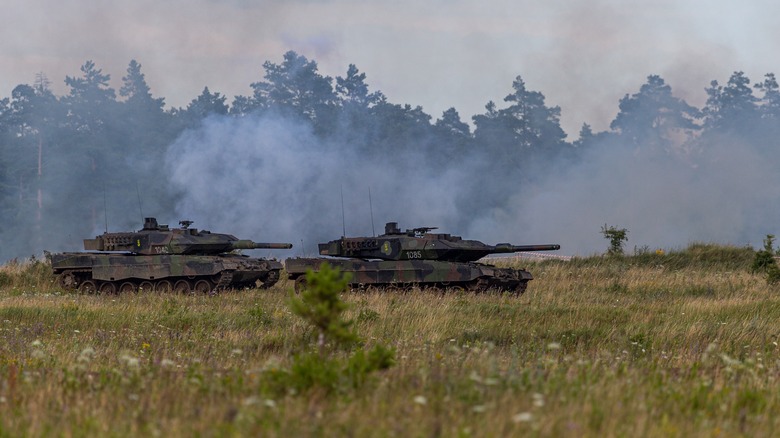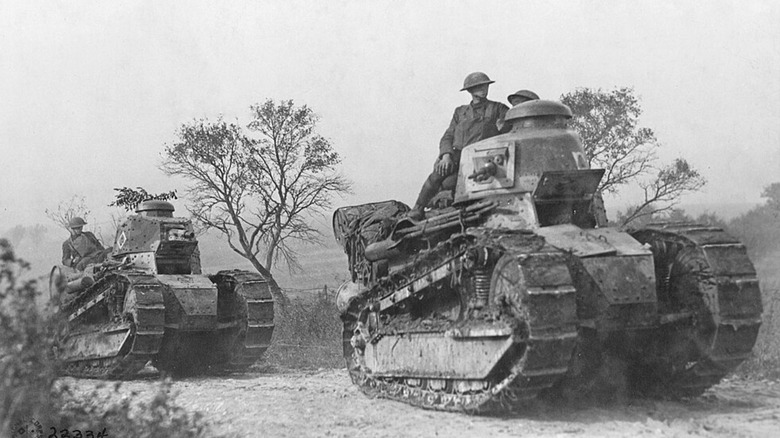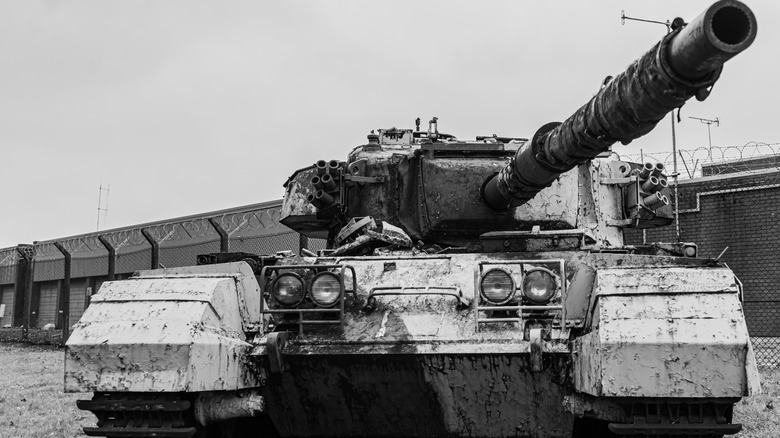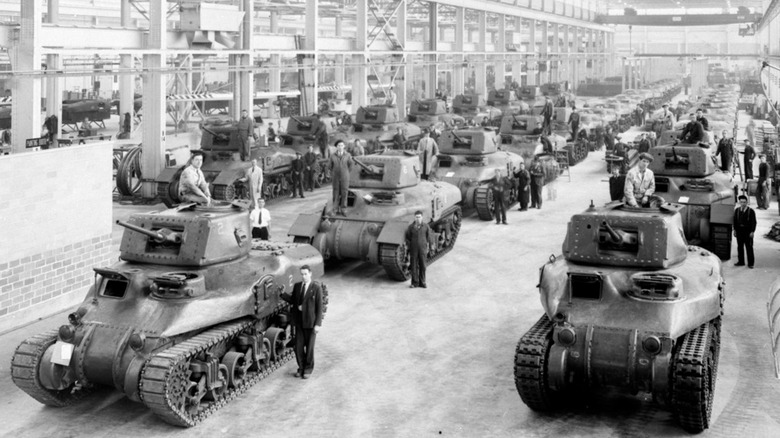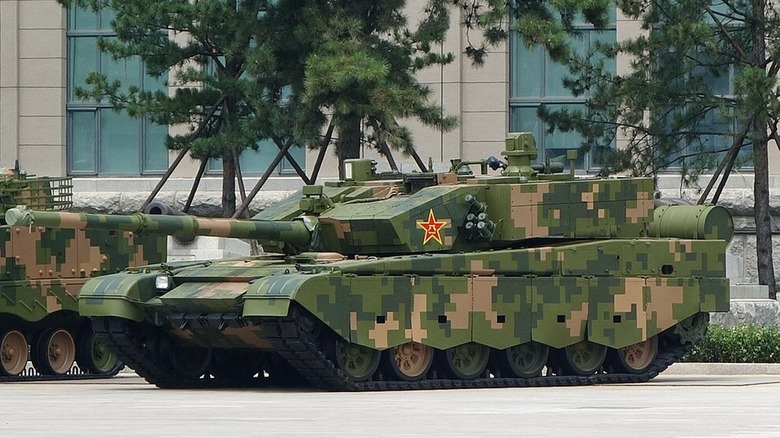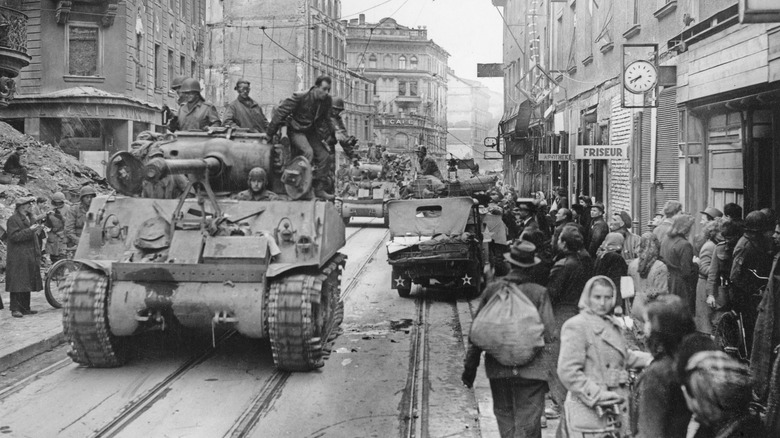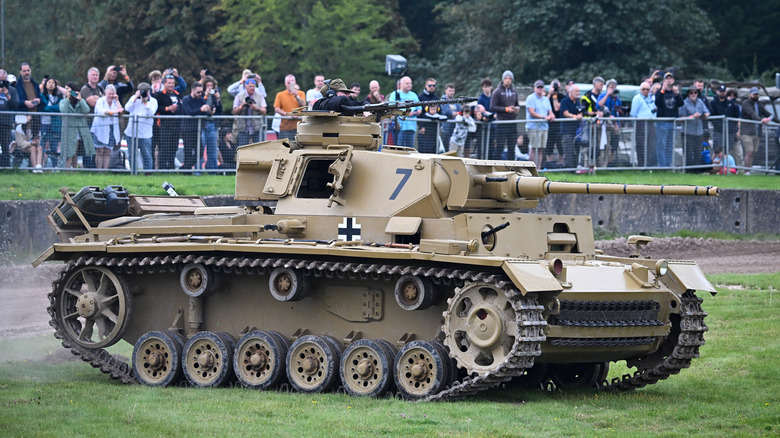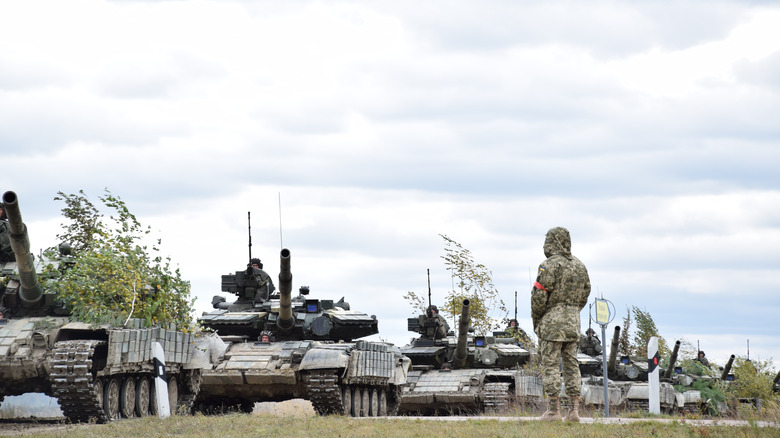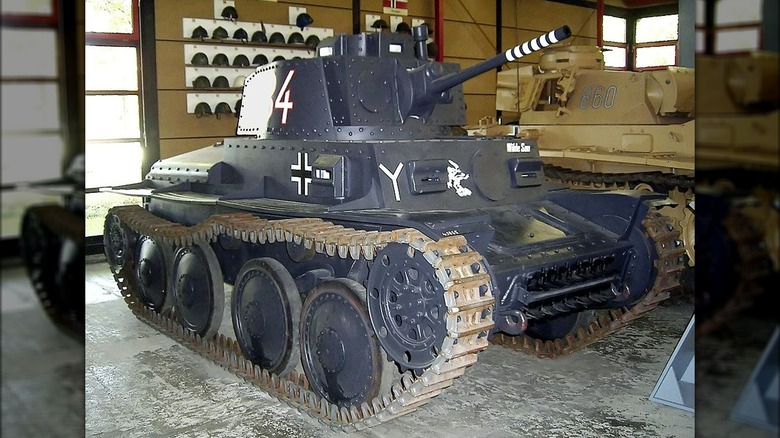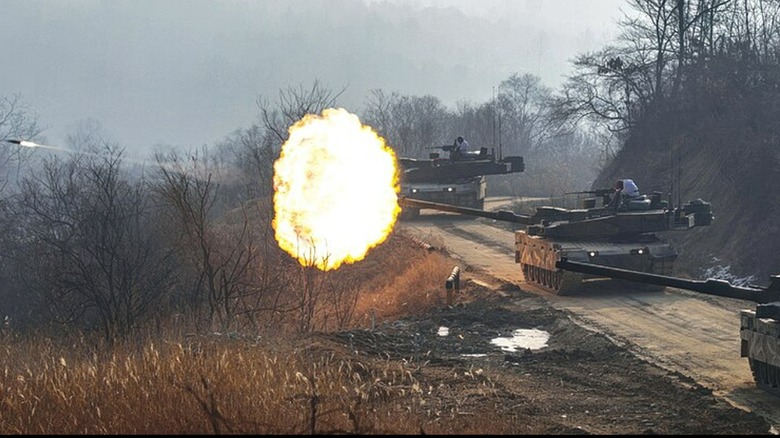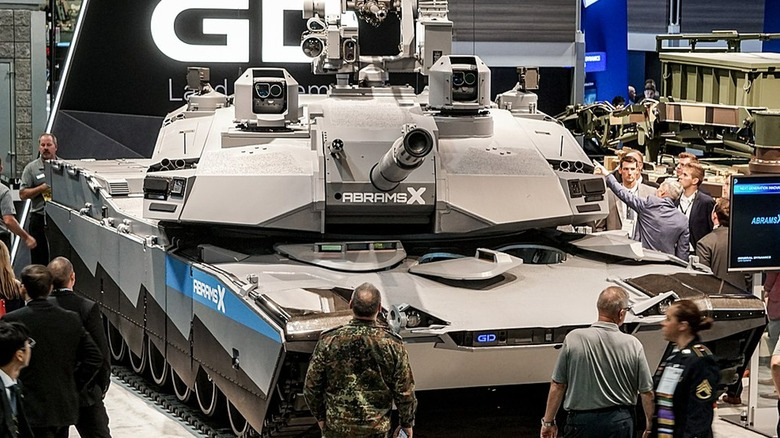10 Innovative Tanks That Redefined Battlefield Utility
Tanks occupy a unique corner of the theatre of war — they're often nimble, yet extraordinarily bulky; heavily armored, and yet utilized in infantry support scenarios. They fill numerous battlefield requirements all at once. Heavy weaponry on these mobile artillery units is crucial in destroying armored targets and entrenched personnel. World War I saw relatively light tank utilization, even as the armored unit was becoming a modernizing feature in warfare. But the bitter, trench conflict that ground down the world population by the millions acted as a strong impetus for mobile armor that could break through enemy lines not 20 years later. The Nazi military relied on rapid tank movements to crush opposition as it stormed through Europe, and in modern times, heavily armored and highly destructive combat readiness remains at the forefront. The Ukrainian army is currently fighting a fierce ground battle, with tank warfare playing a pivotal role in the side's line-busting capabilities.
From the earliest innovators like the Renault FT to the modern behemoths that make up American and South Korean Main Battle Tank divisions, tank design has consistently sought to shake things up on the battlefield. Improving upon design features and incorporating new capabilities lies at the heart of novel tank development — all in the name of increased battlefield supremacy. These are ten tanks that did just that.
Renault FT (France)
This French tank was produced between 1917 and 1918 in magnificent quantities. As a small tank weighing just 7.2 tons and standing almost as tall as a modern NBA big man (measuring 7 feet to its crown), the Renault FT was cheap, agile, and pioneered many modern tank features. The roughly 4,000 built to support the waning days of the French war effort featured a fully rotating turret that encapsulated the armament and made for 360-degree firing coverage. It was the first tank built that incorporated this weaponry mobility, and the capacity for full rotation has become a staple in modern tank design. Similarly, the gearbox and engine found their way into the rear of the vehicle, with the driver positioned along the centerline in the front. Ultimately, these tanks were exported to places like Greece, Yugoslavia, and Poland and even played a role in World War II. The designs were even shared with allies to hustle along production — 1,200 were built in the United States.
The revolutionary design of these tanks transformed armored combat and led the Renault FT to rule the battlefield in World War I. It had a tail designed to keep it upright as it passed over trenches and exploded artillery divots. However, the FT's primary responsibility was traversing no man's land in support of ground pushes, and models were outfitted with one of two armaments: a Hotchkiss 7.93mm machine gun, which took on the moniker of "female," or a Puteaux SA 18 37mm short-barreled gun, which came to be known as "male."
[Featured image by U.S. National Archives and Records Administration via Wikimedia Commons | Cropped and scaled | Public domain]
Centurion (UK)
The Tank Museum boldly claims that "the Centurion is often believed to be the epitome of the tank." Even with such a strong statement opening up the discussion on the vessel, it's immediately clear that the claim isn't controversial or overblown — the Centurion really was one of the most important tanks in British military history. Designed as WWII was coming to a close, it entered the fold in the spring of 1945. It's a heavy example, weighing in at 49.52 tons and serving in more than a dozen national armed services around the world, including Egypt, Israel, and Switzerland. Indeed, one of the most fame-infused scenes of Centurion dominion on the battlefield came during the Yom Kippur War in October of 1973. In one segment of the pitched battle, less than 100 Centurion tanks under Israeli command were caught by surprise by a legion of 500 Syrian T-55 and T-62 units. Over a four-day engagement, the Israeli contingent destroyed half the Syrian armor. In total, the Israelis were outnumbered eight-to-one but managed to rout their enemy.
Centurions remained a staple in the British armed forces for decades, with Beach Armored Recovery Version models making their presence felt during the 2003 Iraq war. They've seen action in twelve wars and supported numerous modernizations and updates (there are 12 model distinctions in total). The first generation of Centurion tanks were armed with a 7.92mm Besa cannon and shipped off to mainland Europe to support the war effort. But while the Centurion saw plenty of combat through the years, its service in 1945 didn't actually include any.
Ram Tank (Canada)
Canada's Ram tank was a domestic enterprise aimed at creating a main battle option for Canadians during WWII. The country was heavily involved in the production of Valentine tanks for the British Army and therefore lacked the resources to fully thrust itself into domestic weaponry development and production. The result was an armor system built on the bones of the M3 model deployed by American forces. However, the platform sat lower than standard and could accommodate a variety of different weapons throughout its production run. The tank never ended up seeing combat, but it served as the basis for new Canadian designs like the Sexton self-propelled gun and Kangaroo armored personnel carrier.
The earliest Kangaroo units were built off the chassis of leftover M7 Priest vessels, but the Ram tank's introduction offered itself as the perfect platform. The personnel carrier build was used extensively in the later stages of the war — taking over definitively from the older builds by October 1944. In direct combat roles, the Ram platform was armed with either a 44mm anti-tank gun or a 57mm variety (after 1942). The tank never saw combat as a true warfighting machine, but the 1,949 produced were a testament to the innovation of Canadian builders and later would go on to experience repurposing and a second act that brought them into the cauldron of battle.
[Featured image by Hayward Studios via Wikimedia Commons | Cropped and scaled | Public domain]
Type 99 Main Battle Tank (China)
China's Type 99 Main Battle Tank is a direct counter to American armor supremacy. The tank got its start from the bare bones of the Type 88 MBT, a tank built in the 1980s, but quickly departs from those roots. It's one of the most expensive tanks ever built, with a price tag reported at $2.5 million apiece. The vessel carries a 125mm smoothbore cannon fitted with an autoloader for efficient firing control. Unlike its predecessors, the Type 99 features modular Explosive Reactive Armor additions along its turret to add crucial defensive capabilities that stand prepared to keep the tank in the fight, even after a direct hit. It's also outfitted with a laser missile deterrence system that can disrupt guidance signals and even hinder enemy optical tools. The tank's autoloader offers a main turret speed of 8 rounds per minute via a traditional Russian carousel-style movement.
The tank supports a crew of three and runs on an INA Turbocharged Diesel engine that powers the tank to a roughly 43-mph top speed. Even weighing in at 54 tons, the tank is highly mobile and the modern ZTZ-99A2 model is believed to support integrated digital battle information systems and improved firing control. Its weapons systems are rounded out by a 12.7mm heavy machine gun that can deliver up to 600 rounds per minute and a 7.62mm machine gun that maxes out at 800 rounds per minute.
[Featured image by Tyg728 via Wikimedia Commons | Cropped and scaled |CC BY-SA 4.0]
M4 Sherman (USA)
This tank is a true icon. The Sherman was mass-produced on a scale unlike anything of its kind, no doubt a factor in the visibility and eventual iconic status of the armored unit. More than 50,000 Sherman tanks were built between just 1942 and 1945 and they really traveled! M4 Shermans saw combat across Europe and North Africa, riding under the flags of numerous allied nations, including the United Kingdom, the Soviet Union, free French forces, and even China. One of the most important features of the M4 design was its maintainability. The tanks primarily saw combat in a support role alongside infantry units and operators often repaired them in the field — even amid bouts of fighting.
What sets the Sherman apart from other American tank designs is its timeliness — as well as some of its improved features. The Sherman model was designed shortly after the Lend-Lease Act was signed (in March 1941), and production began not even a year later. The tank utilized a cast hull and a fully rotating turret. Original M4A1 models showcased a 75mm gun, but this was eventually replaced with the British 76.2mm (or "17-pounder") to keep pace with German weaponry and defensive shielding.
Panzer III (Germany)
Nazi Germany's Panzer tanks were a fearsome sight on the battlefield. Panzer III models were built in a number of variants and largely deployed in North Africa and the Soviet Union. More than 6,200 Panzer IIIs were built in total. The tank utilized a simplified suspension system and followed the same design language as the Vickers Medium Cruiser in crafting a crew area that would support a three-man turret system. Even as later combat would showcase Allied technological ascendency within tank warfare on the western front, the streamlined workspace that German tank teams inhabited created a formidable foe that was efficient and highly capable.
The Panzer III got its start well before the fighting broke out, meaning it was designed thoroughly within a time period governed by the Treaty of Versailles. Tank development was disguised, and by 1934, the third iteration of the Panzer platform was complete and simply waiting for manufacturing to start up again. These tanks led the charge as Nazi Germany invaded Poland, and they functioned as the anti-armor partner to the Panzer IV's infantry support role. Even with streamlined internal cohesion, the first Panzer IIIs lacked the firepower required to seriously threaten their enemies. The early 37mm guns were traded in for a heftier 50mm unit before the tanks arrived in North Africa in February 1941.
T-64 (Soviet Union)
The Soviet Union's T-64 first appeared in 1963 as a revolutionary update to the famous T-62 battle tank model. It combined lightweight maneuverability with heavy armoring that seemed unbefitting of an armored unit only weighing 38 tons. A more compacted engine and transmission system alongside new composite armor made this tank a true warhorse. Perhaps ironically, at the demise of the Soviet Union in 1991, hundreds of T-64BV models were left in Ukraine and are now positioned on the front lines in a war against Russia.
A declassified assessment by the CIA written in 1999 revealed that the T-64B variants had added the capacity to fire anti-tank guided missiles as well as standard munitions via its main gun. More importantly, there was little in the way of visual cues to indicate whether a tank team or low-flying air unit may be facing off against a lesser T-64 or a newer model that could utilize guided missiles. Ultimately, the T-64B variant replaced the older 'A' model as the primary armor unit in Russian tank divisions, making the problem of distinguishing the adversary a temporary issue that never came to fruition for American military personnel. The tank is fitted with a 125mm smoothbore gun that can fire 8 rounds per minute with the help of an autoloader.
CDK LT vz. 38 (Czechoslovakia)
The LT vz. 38 tank out of Czechoslovakia has a truly baffling history. Built privately by CDK to woo the Czechoslovakian government, the tank fell on deaf ears as the country wasn't prepared to invest heavily in military equipment. The design was shopped around, and eventually Iran ordered 50 TNH-designated vehicles, taking possession in May 1937. However, the TNH's claim to fame came a few years later, when 90 tanks built for export to Sweden were gobbled up in the Nazi invasion of Czechoslovakia. The German military was still hungry for weaponry to augment their Panzer armored units, and simply assimilated the TNH models and other LT vz. 38s found in their annexation, rebranding them as Panzer 38(t) tanks.
This light tank ultimately found its way into the fray as a support element. A change from the original design saw a fourth crew member added into the hull to support firing operations, as the task of loading and firing fell to a single crew member located in the turret in the initial layout. Its main weapon was a 3.7cm Skoda gun that fired corresponding Czechoslovakian 3.7cm ammunition. The Germans improved upon these shells, eliminating the cloud of smoke that eventually came to hinder vision directly in front of the tank by bulking up the explosive charge and adding a new cap. The German usurpers also added tracer rounds to make the vessel more effective in the field.
[Featured image by Werner Willmann via Wikimedia Commons | Cropped and scaled | CC BY 2.5]
K2 Black Panther (South Korea)
South Korea's K2 Black Panther is a homegrown main battle tank solution thought to be one of the most impressive examples in production today. It's also the most expensive tank on the battlefield, but for good reason. After the Korean War, South Korea began a hasty search for hefty armor to defend against potential future invasions from the north. During the war, South Korean tank units were composed primarily of light armor from the United States. But combat against heavy Soviet tanks was pitched decidedly against the Allied forces. In the late 1980s, the country's own K1 tanks entered service, with consistent improvements and upgrades culminating in the first 100 K2 tanks entering production in 2014.
The K2 is a 55-ton ordeal — one of the largest military tanks ever built — featuring a 120mm main cannon augmented with an automatic loading function. The main gun is capable of firing roughly 10 rounds per minute, providing immense tactical support to allies in the field. The tank also carries a 12.7mm heavy machine gun and a 7.62mm machine gun for close firing support and rapid suppressive fire. The tank is also equipped with an automatic target detection and tracking system, as well as a hunter-killer function for enhanced combat readiness. Explosive Reactive Armor and Composite Armor are worn across the K2's chassis, and the ammunition compartments are fitted with blow-off paneling to ensure crew safety in the event of a strike that might otherwise detonate the unit's munitions.
[Featured image by ROK Ministry of National Defense via Wikimedia Commons | Cropped and scaled | KOGL Type 1]
AbramsX (USA)
The American Abrams tank has remained one of the most versatile battlefield compliments the world has ever known. The M1 Abrams is widely thought of as the best tank ever made. It offers a top speed of 42 mph and a range of 265 miles, piloted by a crew of four in its current layout (the M1A2 variant). The AbramsX model, unveiled as a technology demonstration in 2022, seems to offer a plethora of meaningful improvements. A heft reduction of around 10 to 20 tons will make it more agile and fuel-efficient, while a hybrid electric-diesel engine further augments the mobility and range of the unit. However, the most impressive upgrade will come in the form of AI integration. A reduction in crew size from four down to three, and the addition of an unmanned turret and enemy detection system underpinned by artificial intelligence make this a supertank of the future.
The unmanned turret is the star of the show for this new update. The Abrams series has recently ballooned in size, making it often unrecoverable on the battlefield. This means broken-down or destroyed tanks may need to be abandoned when plans go sideways. Not needing to protect a person inside the turret means it can be drastically reduced in size, and the autoloader feature means crew will be able to sit in a row rather than scattered throughout the cabin.
[Featured image by Abovfold via Wikimedia Commons | Cropped and scaled | CC BY 4.0]
